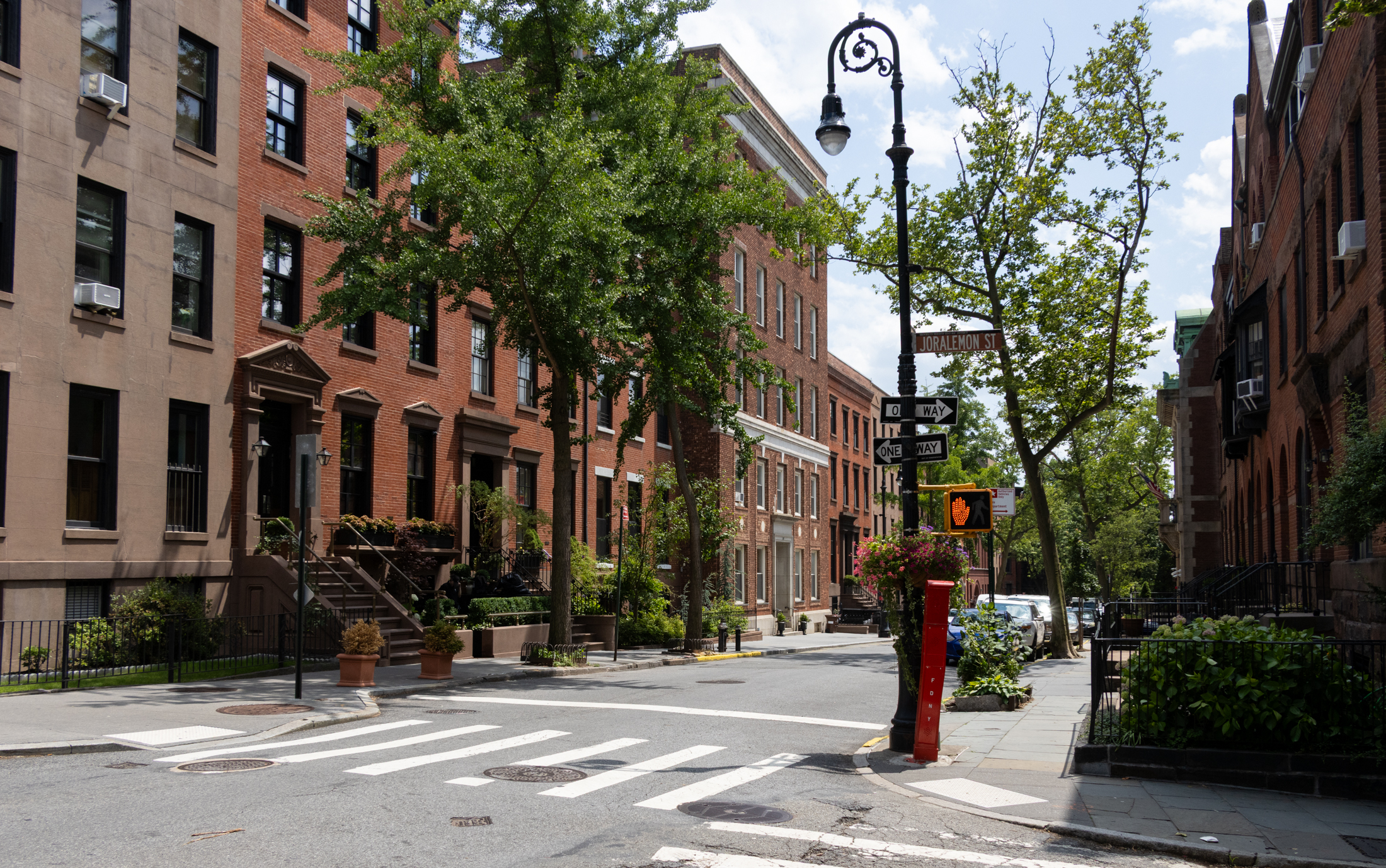Officers' Row: Let's Have Our Cake and Eat It Too
For an event that was whose main purpose seemed to be to present the destruction of Officers’ row as a fait accompli, last night’s public hearing had just the opposite effect. A study by the Army Corps of Engineers of the structural integrity of the ten nineteenth century houses was made available for the public…


For an event that was whose main purpose seemed to be to present the destruction of Officers’ row as a fait accompli, last night’s public hearing had just the opposite effect. A study by the Army Corps of Engineers of the structural integrity of the ten nineteenth century houses was made available for the public to view last night for the first time, and even a cursory look had everyone we spoke to questioning the BNYDC‘s position that the houses are not worth saving; what’s more, there were some creative ideas for alternative designs floated during the public milling-about period that would enable the preservation of Officers’ Row while still providing a large on-site supermarket.
Unbeknownst to us, the 7 o’clock public event was preceeded by a 6:15 press conference where a number of politicians (including Marty Markowitz and Letitia James, above) and Navy Yard officials voiced their support for the creation of a supermarket on the site and did their best to parrot the party line that it is economically unfeasible to save Officers’ Row in the process. To wit:
Hakeem Jeffries:“While historic preservation of this site is a respectable goal, it appears that the deterioration of Admiral’s Row has been so extensive over the years that rehabilitation of the site would be extremely cost prohibitive.”
David Yassky: “After intensive study, responsible preservation entities at every level have concluded that these structures cannot be preserved without a prohibitively high financial commitment.”
Albert Vann: “I am very much in favor of preserving the rich heritage of historical buildings in Brooklyn, but not at the expense of meeting the needs of the people of Brooklyn for fresh produce and jobs.”
If it sounds like they’re all reading from the same script, they are. (For some reason we were erroneously sent an email from the BNYDC soliciting support letters and providing the same talking points that appear in all the submissions.) The problem with the political rhetoric like the quotation from Council Member Vann, in our view, is that it frames the issue as an either-or proposition, and in so doing tries to press familiar class and race buttons that do nothing to further meaningful discussion. This tactic tries to equate an interest in preserving the existing structures with wanting to deprive lower-income people of fresh vegetables. The truth is that this is not an either-or issue. No one on the preservation side of the debate that we’ve talked to is against building a supermarket. If you were a resident of one of the nearby projects, however, that’s certainly the impression you’d get from listening to the public leaders.
The Army Corps of Engineers study that was available for review last night (though not for distribution) put the cost of restoring the ten buildings at about $25 million, significantly less than what the BNYDC has been telling people; what’s more, according to one of the engineers manning the tables, eight of the ten houses are still structurally sound. Additionally, even a back-of-the-envelope sketch like the one above from Pratt’s Brent Porter shows that there may be much more creative solutions that let the community have its cake and eat it too. The BNYDC has done a commendable job at restoring and adaptively reusing much of the rest of the Navy Yard to date and has even more impressive plans for the future; unfortunately, we don’t think that means it should get a free pass to tear Officers’ Row down without a transparent and public process of evaluation. This could be an opportunity to do something really exciting with the six acres of land (and one that takes into consideration factors like what kind of market options may present themselves on nearby Myrtle Avenue). How about a design competition? How about soliciting private funds to lessen any extra burden of preservation? This is too important to let short-term political and economic expediency be the only factors in a decision-making process.
Update: It was just brought to our attention that in his letter yesterday to local, state and federal authorities, Navy Yard president Andrew Kimball did qualify his unambiguous position about a lack of preservation restrictions on the transfer by saying that the renderings that have been circulating are not set in stone:
BNYDC will work with local leaders to organize a design charette with the community in early 2008 to obtain input on the design criteria that should be included in a the Request for Proposal that BNYDC intends to issue shortly thereafter. BNYDC will follow the model established by HPD on the Brig site for community input on the RFP process.
Officers’ Row Preservation Coming to a Contentious Head [Brownstoner]
For Officer’s Row, Supermarket All But Certain [Brownstoner]
Photo of James and Markowitz by Adrian Kinloch.








First, the feds can REQUIRE that the buildings be saved. Then the city and the Brooklyn Navy Yard Development Corp. don’t want them. Fine.
The thing is that the city and BNYDC could be more creative about the financing than the feds can be. This Old House, HGTV, Habitat for Humanity for apartments over the stores, etc. First the will has to be there and the feds can provide it.
Historic preservation increases property values. I don’t know why Bloomberg & Co. haven’t figured that out. It’s greener too because all those bricks don’t go to a landfill to be replaced with somethng shoddier.
Some cities that know the value of unique historic properties have re-built buildings from the ground up and have seen them reinvigorate the neighborhood.
For those who have questioned Shahn Christian Andersen, you should consider his points valid and that the pragmatic issues raised in restoring the Admiral’s Row Houses stem from official cost projections of $ 600 to $ 800 per sq. ft. A gut rehab in Brooklyn’s Clinton Hill or Ft. Greene costs considerably less. A more appropriate figure if a private entrepeneur takes over the redevelopment of an individual house or houses — say, one house for a bake shop in conjunction with the huge adjacent low cost typical grocery store, a building where the production of baked goods could be accommodated entirely within that building while also providing opportunities for local people to be employed and kids to work there after school — then the cost might be around $ 200 per sq. ft. Why not have both the big grocery outlet as well as specialty food shops? Even poor people need bread, and certainly any of us could help bake bread. As to the person who is speaking in behalf of the Federal Preservation guidelines, are you kidding? There is no attention to official landmarking with these houses! Certainly the very best thinking about preservation techniques and materials would hopefully be a part of the project, but how could anyone think that even the Bush administration would justify tearing down historic housing fabric in conjunction with a place where Thomas Jefferson launched a ship nearby within the Navy Yard precinct? Indeed, the very best design competition is in order. My little five minute sketch (not exactly on the back of an envelope but close) was viciously attacked by one of the officers of the Navy Yard. I explained it takes a lot of work to produce a typical computerized rendering and that indeed we would work on a bigger “bird’s eye” image which will show how the existing parking can be incorporated and expanded. But the saddest thing about all this dialogue is the sudden realization that even Leticia James has been bowled over by political forces who go against the most basic grain of public-private dialogue in our city. These jaded people (but not Tish) have become super confident because they think they have won at Atlantic Yards. Surely we as citizens, politicians and both public and private developers can come together to indeed find an acceptable way to integrate the historic houses with a new supermarket; i.e. “have our cake and eat it too!” Brent Porter, Architect; and Associate Professor C.C.E., School of Architecture, Pratt Institute
You show me a non-profit that con afford to help to the tune of tens of millions of dollars and I’ll show you a non-profit that that is turning one hell of a profit.
Atlantic yards is the biggest development site in the City. Comparisons to AY are absurd. THe projects are of completely different scales.
I’m not saying that government can’t help preserve this. WHat I’m saying (for like the 5th time) is that the appropriate sources have already been approached, and they have refused to help preserve this. That’s how the Navy Yard’s current plans came about. First they figured out how much it would cost to preserve the houses. Then they went to all of the sources that could do that and got turned away, and then came up with the current plan.
What I’m trying to tell you is that funding has been very hard to find. WHen you say “funding can come from anywhere” without trying to tell us where there are realistically places for funds to come from, you don’t really counter my argument at all.
– Ella
Your view is limited. Funding can come from anywhere. Atlantic Yards funding is coming from a developer but with huge incentives from the government (who knows, more than 500 million?).
Why can’t the government help preserve this? Or why can’t a non-profit organization also help? Why can’t it be a consortium?
Your view is single minded… and biased towards a developer’s interest.
Don’t sell people short.
Oh, I see. It’s not your job to tell them how to fund their projects, but it IS your job to tell them what those projects should be? Whatever preservationista. I’m starting to think that arguing with you has no point since you are now making some really silly arguments.
And again, I’m telling you that the funding for this has to come from the private sector developer who they will chose to build the supermarket. No developer has been chosen and the navy yard has committed to an open RFP to do so. WHat the Navy Yard has done is some basic market research to understand what kind of financial obstacles the respondents will face and to get a feeling for what those proposals will look like, and it’s pretty clear from that research that if they require the preservation of the Row as one of the prerequisites of the RFP they will get zero feasible responses. All they will get is some pie in the sky response from shahn. ANd when they reject for being crazy, they will take a load of crap from people who don’t know what they are talking about – like you.
-Ella
Shahn-
Your languarge on this site should be a testimonial to your credibility. Don’t buy from Shahn. You’re not dreaming..you’re in brownstoner land.
Excuse me, but it is not my job to tell the Navy Yard how to fund its projects. If they want to hire me to pursue it, I will be more than happy to do so.
Are you trying to tell me they’ve put up all this hype about a supermarket with parking lot, which necessitates the tearing down of the Row, and they don’t have funding, or developers lined up? Please. There’s also a nearby bridge for sale.
Like AY, when alternative possiblities for a site are proposed, the powers in charge poo-poo them, and dismiss them without even really considering them, because they have a vested interest in doing what they want to do. The same is true here. Frankly, I don’t understand why the Navy Yard does’t want to even save one of the houses, as they have shown a distinct preservationist streak.
I would like to think that maybe they are in a rock/hard place position with perhaps the city dangling something over their heads that they feel is more important than the Row. If so, then just be honest enough to say so. I can live with that a lot easier than a blithe dismissal of any good ideas by one of their unofficial flacks. You telling me they’ve tried, and just can’t do it doesn’t cut it.
Preservationista
What’s wrong with the basic premise? Just about everything. Once again you haven’t spent even one sentence about how it will get funded, other than saying that you’re sure that someone will figure it out somehow. Well what I’m trying to tell you is that the people who’s responsibility it is to figure it out (BNYDC) are trying very clearly to tell you that they’ve tried and they can’t figure it out. It’s not a matter of just stretching some budgets here or there. The numbers are of by orders or magnitude.
Just because there are plans afoot doesn’t mean that money is lined up. Just because there are other sites in the neighborhood that “could” fit a supermarket doesn’t mean they are going to. Those sites can also support a whole lot of other uses, and chances are they will support those uses instead.
I’ll tell you what the “cabal” is afraid of. They are afraid of bad ideas with no chnace in hell of working, and all their time being wasted, and then a new administration comes in and they are replaced without getting anything accomplished. And then a new admin comes in and starts over again from scratch and all their time is wasted again because people like Shahn try to sell them pipe dreams, and this cycle repeats itself till the houses just fall down by themselves and then we can get on with it.
What does the Navy Yard have to gain from knocking down these houses? Obviously they don’t have an anti-preservation agenda. A short stroll around the yard will show you that they’ve spent millions over the past several years preserving the 19-th century warehouses in the yard, and they’ve already announced several initiatives to preserve more historic buildings in the yard (The hospital, Building 1, building 92, and the Sands Street Gate, to name a few). So obviously, if they thought they could save this one, they would. They just don’t think it’s doable, and don’t want to waste the time to prove it to you, when they’ve already proven it to themselves.
How much public money would the city be spending to save these houses (as opposed to monies from the private sector)?
That’s the bottom line for me — beyond a certain point you have to ask if this is the best use of city funds.